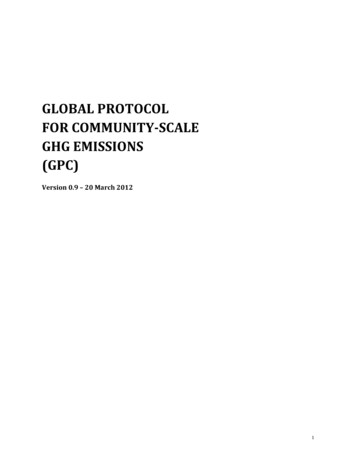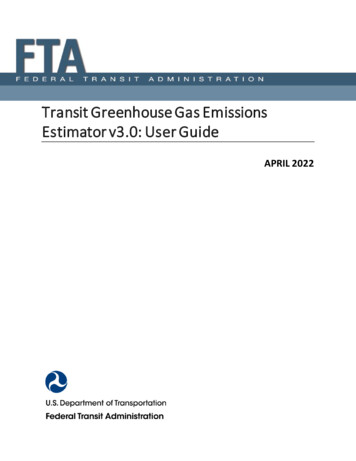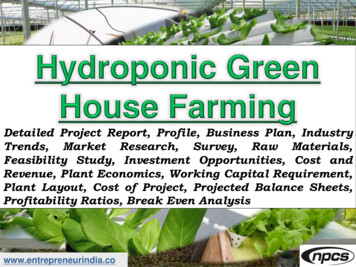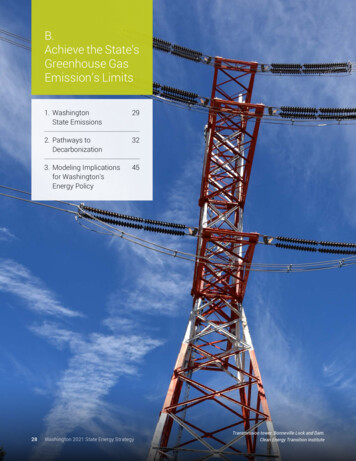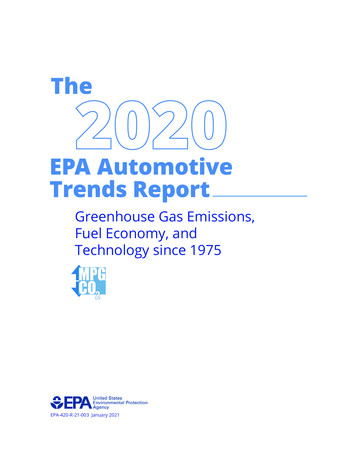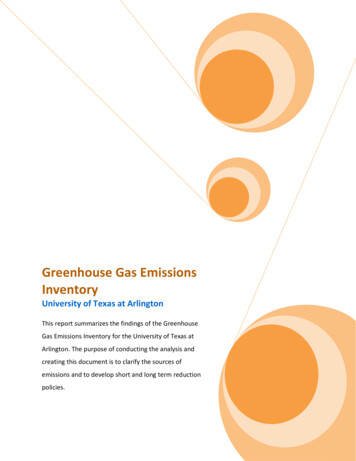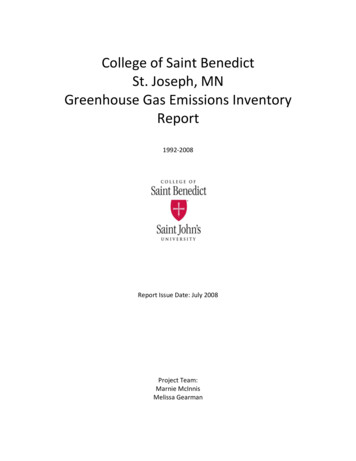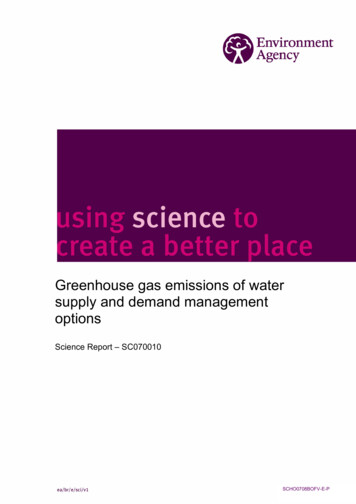
Transcription
Greenhouse gas emissions of watersupply and demand managementoptionsScience Report – SC070010iScience Report –- Greenhouse gas emissions of water supply and demand management optionsSCHO0708BOFV-E-P
The Environment Agency is the leading public bodyprotecting and improving the environment in England andWales.It’s our job to make sure that air, land and water are lookedafter by everyone in today’s society, so that tomorrow’sgenerations inherit a cleaner, healthier world.Our work includes tackling flooding and pollution incidents,reducing industry’s impacts on the environment, cleaning uprivers, coastal waters and contaminated land, andimproving wildlife habitats.This report is the result of research commissioned andfunded by the Environment Agency’s Science Programme.Published by:Environment Agency, Rio House, Waterside Drive,Aztec West, Almondsbury, Bristol, BS32 4UDTel: 01454 624400 Fax: 01454 624409www.environment-agency.gov.ukISBN: 978-1-84432-921-2 Environment Agency – July 2008All rights reserved. This document may be reproducedwith prior permission of the Environment Agency.The views and statements expressed in this report arethose of the author alone. The views or statementsexpressed in this publication do not necessarilyrepresent the views of the Environment Agency and theEnvironment Agency cannot accept any responsibility forsuch views or statements.This report is printed on Cyclus Print, a 100% recycledstock, which is 100% post consumer waste and is totallychlorine free. Water used is treated and in most casesreturned to source in better condition than removed.Further copies of this report are available from:The Environment Agency’s National Customer ContactCentre by emailing:enquiries@environment-agency.gov.ukor by telephoning 08708 506506.iiAuthors:Emma ReffoldFeifei LeightonFida ChoudhuryPaul S Rayner(Halcrow Group Ltd)Dissemination Status:Released to all regionsPublicly availableKeywords:Water supply, demand management, carbon,greenhouse gas, energyResearch Contractor:Halcrow Group LtdBurderop Park, Swindon, SN4 OQD01793 812479Environment Agency’s Project Managers:Andy Howe, Environmental PolicyMike Briers, Science DepartmentScience Project Number:SC070010Product Code:SCHO0708BOFV-E-PScience Report –- Greenhouse gas emissions of water supply and demand management options
Science at theEnvironment AgencyScience underpins the work of the Environment Agency. It provides an up-to-dateunderstanding of the world about us and helps us to develop monitoring tools andtechniques to manage our environment as efficiently and effectively as possible.The work of the Environment Agency’s Science Department is a key ingredient in thepartnership between research, policy and operations that enables the EnvironmentAgency to protect and restore our environment.The science programme focuses on five main areas of activity: Setting the agenda, by identifying where strategic science can informour evidence-based policies, advisory and regulatory roles; Funding science, by supporting programmes, projects and people inresponse to long-term strategic needs, medium-term policy priorities andshorter-term operational requirements; Managing science, by ensuring that our programmes and projects are fitfor purpose and executed according to international scientific standards; Carrying out science, by undertaking research – either by contracting itout to research organisations and consultancies or by doing it ourselves; Delivering information, advice, tools and techniques, by makingappropriate products available to our policy and operations staff.Steve KilleenHead of ScienceiiiScience Report –- Greenhouse gas emissions of water supply and demand management options
Executive summaryReducing greenhouse gas emissions is one of the key challenges of our generation.The UK Government has recognised the necessity for significant reductions. The SternReport, Energy White Paper and Climate Change Bill provide the scientific andlegislative impetus to mitigate and adapt to the effect of emissions across all sectors ofthe UK.The water industry must play its part and reduce its greenhouse gas footprint. Watertypically requires treatment prior to use and on its return to our environment. It ispumped and pressurised to reach our homes. All of these activities require energy andtherefore result in greenhouse gas emissions.The water industry contributes 0.8 per cent of annual UK greenhouse gas emissions.However, the emissions that result from heating water in the home increases this figureto 5.5 per cent.This project examines the difference in greenhouse gas emissions associated with avariety of options for supplying water and using it more efficiently. We assess optionsfor new supplies of water, working with an existing water supply network, plus methodsand products to reduce and manage households’ water demand. This study does notinclude any assessment of other environmental, social or economic costs and benefits.We provide an evidence base and framework to inform our understanding of waterresource and carbon impacts, underpinning one of five modules of our new waterresource strategy for England and Wales, planned to be published in December 2008.This is also one report in a wider two-year project looking at the potential for energyefficiency and carbon reduction across the entire water industry.Throughout the report we refer to greenhouse gas emissions as carbon dioxideequivalent (CO2e). The cost of CO2e follows the Defra Shadow Price of Carbonguidance; 26 per tonne in 2008, thereafter rising by two per cent each year. Thisreport does not include any assessment of other environmental, social or economicfactors. We recognise that quantifying greenhouse gas emissions is just one factor tobe considered in the overall decision-making process.Our key findings1. 89 per cent of carbon emissions in the water supply - use - disposal system isattributed to "water in the home" and includes the energy for heating water(excludes space heating), which compares with public water supply andtreatment emissions of 11 per cent.2. Simple demand management measures, particularly those which reduce hotwater use, have significant potential to not only promote water and energyefficiency but also to reduce the carbon footprint of the water supply - use disposal system. For example, moving to full water metering across Englandand Wales could reduce annual emissions by 1.1 - 1.6 million tonnes of carbondioxide per year. Moving to full metering in areas of serious water stress couldpotentially reduce annual emissions by between 0.5 - 0.75 million tonnes CO2eper year.ivScience Report –- Greenhouse gas emissions of water supply and demand management options
3. All supply side measures result in an increase in carbon emissions (we assumenew schemes are implemented to meet rising demand rather than replacingexisting assets). There is often a wide range in carbon emissions associatedwith water supply schemes of a similar type, and therefore overlap betweendifferent types of schemes is common. For example, medium to large reservoirsand indirect effluent re-use can have similar carbon emissions per volume ofwater supplied, dependant on scheme design. To select the lowest carbonsolution requires a scheme by scheme assessment.4. Most demand management options, for example water metering, have lowoperational carbon emissions, the exception being retrofitting of householdrainwater harvesting and greywater recycling to existing homes. Dataconcerning the energy use of these two techniques is scarce and requiresfurther research.5. Combinations of demand management options, even those including rainwaterharvesting in new homes, offer larger water savings compared to individualwater efficiency options and still compare favourably to supply side options interms of overall lower carbon emissions.6. Current legislation continues to require the sustainable management of riversand groundwater. In some cases this will mean that water abstraction will needto be reduced to ensure a sustainable water environment, resulting in areduction in the water available for supply. To offset this effect, companies areinvestigating alternative sources of water. Our work indicates this will increasecarbon emissions overall. We believe that widespread implementation ofdemand management measures can offset or further reduce overall emissions,as well as reducing the need for some of these new supplies in the first place.For example an initial assessment using South East data indicates that thelowest carbon cost is delivered by the scenario which includes both demandmanagement for two million homes and 18 new supply schemes, delivering a14 per cent carbon cost saving compared to business as usual.7. We acknowledge that future technological developments may offer greaterenergy and carbon savings to both water supply and demand managementoptions. The extent of these savings has not been looked at in this study due tothe level of uncertainties involved.8. In future, policies need to consider the greenhouse gas emissions across thewhole of the water system, i.e. emissions arising from both the water industryand the use of water by consumers. Policy-makers also need to recognise thepotential overlap with the aims of energy efficiency initiatives and ensure thereis no double counting of carbon reductions.9. Water Resource Management Plans require water companies to assess theircarbon footprint related to water supply only and not the whole life cycle costs.Water companies planning future water resources options through the 25 yearplanning period are required to build-in the shadow price of carbon to theeconomic analysis. However, this typically relates to the direct energy costs ofwater production and embedded carbon for construction activities.This current approach constrains the options appraisal as it fails to take fullaccount of the life cycle costs of carbon and particularly the positive impact ofdemand management related to water use in the home as well as wastewateractivities. This approach has therefore been unable, to date, to incorporate thelargest and most significant aspects of carbon accounting within assessmentsbetween building new resources and managing demand.vScience Report –- Greenhouse gas emissions of water supply and demand management options
The life-cycle emission modelWe assessed new water supply options and demand management options workingwith an existing water supply network. The options considered included: Supply options - storage reservoirs; regional water grids via transfer pipelines;desalination plant to make seawater and brackish water drinkable; effluent reuse; groundwater and river abstractions. Demand management options - water saving devices for toilets, showers andbaths; water meters; water efficient domestic appliances; rainwater collectionsystems; grey-water recycling (i.e. water from showers, baths and sinks usedfor toilet flushing); water mains leakage reduction.We developed our methodology in line with Defra guidance on the Shadow Price ofCarbon and our guidance on water resources planning. Present value techniques areused to compare options in terms of their carbon cost as CO2e versus water deliveredor saved over a planning horizon of 60 years.We model the life-cycle impact of individual options by calculating the greenhouse gasemissions associated with construction, manufacture, installation, maintenance andoperation. For a unit of water we evaluate the current carbon emissions and cost of carbon. For water supply options we calculate the scheme carbon cost, e.g. newreservoir, new treatment facilities - clean and wastewater, and increasedcapacity in the distribution network. For demand management options we calculate the carbon cost to introduce andoperate the measure and the carbon savings from lower water demand.The model, built in MS Excel for ease of use, is intended for high-level carbon costappraisal in advance of more detailed study. It can be easily tailored to suit regionaland scheme specific data as appropriate, and should help in our review of watercompany PR09 plans.ConclusionsOur study, as part of a broader project on energy efficiency and carbon emissionreductions across the water and wastewater sector, provides a first evidence base forwater supply and demand management options. To create this evidence, wedeveloped at a strategic level an initial methodology for carbon cost assessment,producing results that can be built on.The model framework can be used to compare the carbon impacts of individual supplyand demand options. Key details of construction and operation are adjustable to reflectactual schemes, or to explore the carbon implications of different designs.Our results show that simple demand management measures, such as metering, havethe potential for significant carbon reduction through reducing energy usage associatedwith heating water in the home. Water efficiency measures could provide a significantreduction in UK carbon emissions, and reduce our individual energy and water bills.Successfully implementing the right balance of low carbon supply side solutions andwider implementation of water demand management activities now can begin theprocess of moving towards a lower carbon water industry. Getting it wrong will leave alegacy of carbon intensive water management which will remain with us for decades tocome.viScience Report –- Greenhouse gas emissions of water supply and demand management options
AcknowledgementsThanks are extended to the members of the project steering group:vii Keith Colquhoun, Climate Change Strategy Manager, Thames Water. Nicole Pay, Energy Manager, Yorkshire Water. Bruce Horton, Climate Change Policy Advisor, Water UK. Mike Keil, Head of Climate Change, Ofwat. Delvin Lane, Senior Accounts Manager, Carbon Trust. David S Jones, Senior Policy Advisor, Defra. Charles Ainger, Sustainable Development Director, MWH UK. Trevor Bishop, Head of Water Resource Management, Environment Agency. John Fraser, Head of Water Quality, Environment Agency. Julie Foley, Head of Sustainable Development, Environment Agency. Julian Wright, Climate Change Policy Advisor, Environment Agency.Science Report –- Greenhouse gas emissions of water supply and demand management options
ContentsScience at the Environment AgencyiiiExecutive 1.1Background11.2Objectives11.3Report outline22Carbon reduction32.1Overview32.2Carbon and energy use in water resources32.3Stern Review32.4Climate Change Bill42.5The Government's water strategy for England42.6Placing a value on greenhouse gas emissions52.7Water resources planning - Environment Agency guidance62.8UKWIR carbon accounting guidelines62.9Ofwat's carbon accounting requirements72.10Comparing carbon costs of different options72.11Related international studies83Water supply & demand management options93.1Overview93.2Options considered93.3Options for water supply113.4Options for water demand reduction123.5Scale issues164Methodology174.1Overview174.2Outline methodology174.3Carbon footprinting174.4Life-cycle carbon emissions194.5Boundaries194.6Life-cycle Approach23viiiScience Report –- Greenhouse gas emissions of water supply and demand management options
5Carbon cost assessment model245.1Overview245.2Model structure245.3Model principles255.4Model assumptions275.5Total system carbon cost295.6Modelling water supply options305.7Modelling water efficiency options325.8Modelling combinations of water efficiency options365.9Carbon footprint examples375.10AICC calculation examples396Model results416.1Overview416.2Carbon footprint of water supply options416.3Carbon footprint of water efficiency options446.4Carbon footprint of water efficiency options in combination486.5Comparing supply and demand options506.6Uncertainty537Worked Example - South East region557.1Overview557.2South East region557.3Water resource planning scenarios557.4Basis for carbon cost assessment577.5Carbon cost assessment model results578Concluding remarks59References62List of abbreviations66Appendix A Carbon Cost Model - water supply options67Appendix B Carbon Cost Model - demand management options76ixScience Report –- Greenhouse gas emissions of water supply and demand management options
Table 3.1Table 3.2Table 3.3Table 4.1Table 5.1Table 5.2Table 5.3Table 5.4Table 5.5Table 5.6Table 5.7Table 5.8Table 5.9Table 6.1Table 6.2Table 6.3Table 6.4Water supply optionsDemand reduction optionsTargets for water use in new homesWater UK GHG Emissions DataKey sources of dataWater efficiency optionsDemand Management CombinationsExample carbon emissions calculation - metering & toiletExample carbon footprint calculation - meteringExample carbon footprint calculation - low flush toiletExample AICC calculation - benchmark AICC for water sectorExample AICC calculation - water supply reservoir optionExample AICC calculation - demand management metering optionCarbon cost model results - water supply optionsCarbon Cost Model Results - Water Efficiency OptionsDemand Management Combinations - model results for 1000 homesModel results - relative impact of options at household level1011141825353738383839404043464950Figure 2.1Figure 2.2Figure 4.1Figure 4.2Figure 4.3Figure 4.4Figure 4.5Figure 5.1Figure 5.2Figure 5.3Figure 5.4Figure 5.5Figure 5.6Figure 6.1Figure 6.2Figure 6.3Figure 6.4Figure 7.1Figure 7.2Schedule of Shadow Price of Carbon (CO2e)Average Incremental Social Cost compared with CO2e CostIllustration of carbon footprinting for a schemeWater sector greenhouse gas emissions, 2005/06Water supply-use-disposal systemConceptual model of water supply option - desalinationConceptual model of demand management - meteringCarbon cost assessment model: modular structureCarbon emissions for total water system - UK average (2006/07)Carbon footprint for the current water supply - use - disposal systemOutline carbon cost assessment of water supply option – reservoirExample carbon footprint model of water supply optionExample carbon footprint of demand management - metering optionCarbon Cost Model Results - Water Supply OptionsCarbon Cost Model Results - Water Efficiency OptionsCarbon cost model results for combined water efficiency optionsModel results - relative impacts of optionsWater Resources in South-East, Regional Model Network SchematicCarbon cost for South East region nce Report –- Greenhouse gas emissions of water supply and demand management options
1Introduction1.1BackgroundRecent publications such as the Stern Report, the Climate Change Bill and the EnergyWhite Paper highlight the ever increasing focus on climate change and greenhousegases. The Government programme for tackling these issues will have implications forthe Environment Agency’s responsibilities as regulator of the environment in Englandand Wales.Our study forms part of a broader project examining the potential for increased energyefficiency and carbon emission reductions across the water and wastewater sector.This study explores the link between water resources, energy and carbon emissions.Both water supply and demand management options are considered, consistent withthe twin-track approach to water resources planning.The carbon footprint specific to water resources planning options and the emergingprice review 2009 (PR09) is a new area of work, with knowledge as to how theproposed options to meet future water demand and efficiency compare in carbon costterms beginning to emerge.As a first step in carbon cost assessment, the study delivers: (a) an evidence basederived from energy and carbon emission datasets related to water supply and demandmanagement options; (b) a carbon cost assessment model (in MS Excel ) developedfrom these datasets; and (c) results illustrated for options using water company data forthe South-East of England (illustrative purposes only).Decision making in water resources planning encompasses a range of environmental,social and economic factors. This study only examines energy usage and greenhousegas emissions at a strategic level.The study output is intended for use in strategic water resources planning to appraiseand compare the different water resource options based on their carbon cost. Thefindings will inform the carbon module which is part of our new water resourcesstrategy for England and Wales, planned to be published in December 2008.In this report, the term "carbon" is shorthand for greenhouse gases and presented ascarbon dioxide equivalent (CO2e).1.2ObjectivesThe study aims to gather data so that potential investments in different water supplyand water demand management options may be appraised more fully, specifically interms of their carbon costs.The main objectives of the study are to: gather energy and carbon emissions data for common water supply anddemand management options. examine the carbon impact of options individually, and in combination develop a carbon cost assessment model to assist in the evaluation of differentwater supply and demand options. illustrate the carbon assessment based on worked examples for water resourceplanning scenarios for the south east of England.Science Report –- Greenhouse gas emissions of water supply and demand management options1
The high-level results from this study will inform our technical review of water companyplans. There is scope for further study and development of the carbon cost model. Atthis stage, we propose to make the model freely available to academics/practitionersso that the work can be interrogated and to help in developing best practice. The modelis built in MS Excel for ease of use.1.3Report outlineThis study report is organised in the following sections:2 Chapter 2 outlines legislation and guidance relating to carbon and the watersector; Chapter 3 examines the various options for water supply and demandmanagement; Chapter 4 explains the carbon "footprint" concept and methodology for thisstudy; Chapter 5 presents the carbon cost assessment model; Chapter 6 presents the carbon cost of standard supply/demand managementoptions; Chapter 7 illustrates the carbon costs for some example South East options; Chapter 8 sets out the conclusions and recommendations of this study.Science Report –- Greenhouse gas emissions of water supply and demand management options
2Carbon reduction2.1OverviewThe Stern Review calls for global action on climate change and suggests reductiontargets for global carbon emissions. This chapter explains the UK strategy to addressclimate change, stemming from the Stern report and set in legislation. We explain thecurrent Defra guidance on carbon cost assessment, and how this relates to theEnvironment Agency’s guidance on water resources planning. This study adoptsDefra’s guidance in carbon cost assessment within its methodology.In subsequent chapters we evaluate how different water supply and demandmanagement options compare in terms of total greenhouse gas (GHG) emissions. Thisfocus on both demand management and supply side options is consistent with theEnvironment Agency’s twin-track approach to water resources planning.2.2Carbon and energy use in water resourcesAs carbon dioxide is a major contributor to climate change, the need to offset or reducecarbon production has risen high in national and international political agendas.The Government has identified a significant potential to reduce carbon cost-effectively,and to promote energy efficiency. There are a number of initiatives to this work, suchas the Climate Change Bill and the proposed Carbon Reduction Commitment. The Billproposes five-yearly targets to reduce carbon dioxide and at least a 60 per centreduction by 2050 compared to 1990 levels.The water and wastewater sectors fall within these initiatives. Many large scaleresource development options such as desalination, pumped storage reservoirs andeffluent re-use are recognised as relatively energy intensive both in terms of operationand construction. Demand management may result in lower energy use, which couldoffset future energy pressures and reduce carbon emissions. However, the evidencebase for GHG associated with different strategies is fairly poor; this study seeks toclarify the relative carbon impact between new water resources and demandmanagement.2.3Stern ReviewThe Stern Review stated that the risks of the worst impacts of climate change can besubstantially reduced if GHG levels in the atmosphere can be stabilised between 450and 550 parts per million (ppm) CO2 equivalent (CO2e). The current level is 430ppmCO2e, rising at more than 2ppm each year.Total emissions are predicted to continue to rise for the next 10 to 20 years, but thenthey need to fall by at least 1 per cent to 3 per cent per year. Stabilisation will requireglobal emissions to be at least 25 per cent below current levels by 2050. Any delay inreducing emissions will miss the opportunity to stabilise at even between 500 and550ppm CO2e.Science Report –- Greenhouse gas emissions of water supply and demand management options3
2.4Climate Change BillClimate change legislation will form a fundamental part of the UK's strategy to tackleclimate change and address the issues raised by the Stern Review. The ClimateChange Bill sets the UK's target to reduce carbon dioxide emissions through domesticand international action by 26-32 per cent by 2020 and at least 60 per cent by 2050,against a 1990 baseline.The Bill contains enabling powers to introduce new trading schemes, such as theCarbon Reduction Commitment (CRC), through secondary legislation. The CRC willtarget emissions from energy use by large organisations whose annual mandatory halfhourly metered electricity use is above 6,000 MWh. This scheme focuses on thoseemissions outside the Climate Change Agreements (CCAs) and outside the directemissions covered by the EU Emissions Trading Scheme (EU ETS).The CRC, which is likely to be introduced in 2010, will cover the water sector andrequire all water companies to participate in a cap and trade scheme for carbonemissions. It will provide an additional driver for water companies to put a price on theircarbon emissions for planning purposes.Our study is based on the Shadow Price of Carbon (SPC) methodology set by Defra forcarbon cost assessment. Given the CRC is still being developed at this time we havenot attempted to capture the implications of this scheme for water companies - this isan area for future study as more guidance comes to light.2.5The Government's water strategy for EnglandFuture Water published in February 2008 sets out the Government's vision forsustainable delivery of secure water supplies and an improved and protectedenvironment.The water strategy emphasises the key role of the water sector in mitigating climatechange by taking action to reduce their GHG emissions wherever possible. Theseemissions arise primarily from water treatment, supply and wastewater disposalactivities, and from water use by customers.The strategy document provides the following data on water industry GHGs: emissions arise from abstracting, pumping, treating and heating water andtreating and pumping wastewater in the water sector; In 2006/07 the water industry used almost 7,900 GWh of energy for itsoperations with emissions (CO2e) of over five million tonnes; around 56 per cent of these emissions derive from wastewater, 39 per centfrom water supply and five per cent from administration/transport by the waterindustry (2005/06).The strategy further highlights that the use of hot water in homes for such things aspersonal and household washing, cooking and cleaning, but excluding that for heatingthe home, contributes roughly 35 million tonnes of GHGs (CO2e). This is seven timesas much as that emitted by the water industry, and amounts to over five per cent oftotal UK emissions.Water efficiency measures are cited as a real "win-win solution" as they reduce energyuse and water use, thereby reducing GHG emissions. Those measures that focus onreducing hot water would result in much larger energy savings.4Science Report –- Greenhouse gas emissions of water supply and demand management options
The strategy concludes that the need for adaptation to climate change as well as itsmitigation is unquestionable. The impact of climate change must be fully consideredand integrated in all water policy and management.2.6Placing a value on greenhouse gas emissionsDefra guidance sets out how to value GHG emissions based on the concept of theShadow Price of Carbon (SPC), which supersedes the Social Cost of Carbon (SCC).The SPC captures the estimated damage costs of climate change caused by eachadditional tonne of GHG emission, expressed as CO2e.The Defra guidance defines the following approach: Step 1: quantify the impact on GHG emissions - in tonnes of CO2e; Step 2: calculate the SPC schedule over the planning appraisal period setalongside the GHG quantities saved, as illustrated in Figure 2.1 (extract fromDefra interim guidance document); Step 3: multiply each year's GHG quantities abated/emitted (CO2e) by SPC; Step 4: use these monetised GHG values in cost-benefit analysis.The SPC thus depends on the year the carbon is abated/emitted. In 2007 the SPC is 25.5 (per tCO2e), rising at two per cent per annum to 26.0 in 2008 and 50 in 2040.We use only this uplift in our carbon-cost assessment and exclude others such as theRetail Price Index (general purpose domestic measure of inflations). The cost-benefitanalysis follows Treasury Green Book guidance.Figure 2.1 Schedule of Shadow Price of Carbon (CO2e)The SPC captures the damage costs of climate change caused by each additionaltonne of GHG (CO2e) emitted, i.e. it reflects the adaptation costs under a 'business asusual' scenario assuming society does nothing to mitigate the climate change effects.However there remains great uncertainty about the damage and adapt
with an existing water supply network. The options considered included: Supply options - storage reservoirs; regional water grids via transfer pipelines; desalination plant to make seawater and brackish water drinkable; effluent re-use; groundwater and river abstractions. Demand management options - water saving devices for toilets .

